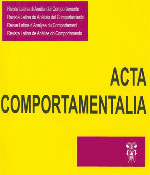Cooperative Behaviors: A review of procedures and result
Main Article Content
Abstract
A review of various procedures on cooperative is presented in this paper. First, Hake and Vukelich´s (1972) classification is introduced. Cooperative situations are characterized, first, by the fact that reinforcement of a subject’s behavior is at least in part dependent on the responses of another subject and, second, by the fact that the situation allows such responses, designated as cooperative responses, to result in an equitable division of responses and reinforces. In that framework, an increase in cooperative responses is indicative of minimal cooperation, whereas an increase in the degree of corresponded between the cooperative responses is indicative of maximal cooperative effect. Then, the results coming from experiments with mutual control of rein forcers (the mutual-fate control situation) are described. This situation was initially studied by Sidowsky, Wyckroff and Tabory (1956). In this task, two subjects interact together and each subject has control only over the reinforces and punishers delivered to the other subject. Then the conception of Kelley, Thibaut, Radloff and Mundy (1962) about the evolution of cooperative behavior is considered. According to these authors, cooperative behaviors are the outcome of an implicit rule (such as, for instance, “win-stay, loose-shift”) followed by the subjects. This would explain the emergence of cooperative behaviors under certains conditions, local inequity can appear. Finally, the behaviors usually related to cooperative contingfencies (such as audit behaviors or phenomena related to “leadership”) are briefly discussed.
Article Details
Citas en Dimensions Service

<a rel="license" href="http://creativecommons.org/licenses/by-nc-sa/4.0/"><img alt="Licencia de Creative Commons" style="border-width:0" src="https://i.creativecommons.org/l/by-nc-sa/4.0/88x31.png" /></a><br />Este obra está bajo una <a rel="license" href="http://creativecommons.org/licenses/by-nc-sa/4.0/">licencia de Creative Commons Reconocimiento-NoComercial-CompartirIgual 4.0 Internacional</a>.
